|
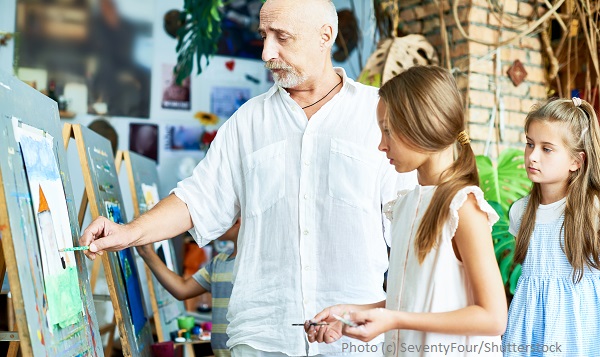
Learning in the Real World
By Wendy Priesnitz
A retired school teacher acquaintance recently acquired her first computer. After plugging it in and connecting the components according to the instructions, she called me to ask if I could recommend a course that she could take to learn how to use her new toy. I said I couldn’t recommend a course because I’ve never taken a computer course in my life. Then how in the world, she wondered, had I become such a proficient computer user? Well, I responded, I just began using it!
I hadn’t given much thought to it before, but I realized then that I learn most things by just doing them. And I suppose that made me a good role model for our life learning daughters when they were young…or at least it helped me understand that “just doing it” can be an effective way to learn. And that, of course, is fundamental to my philosophy of living and learning.
It’s also fundamental to how all children learn to walk and to talk. They don’t take a course. They don’t “goof off” while learning it because they’re bored or it’s too hard. They are not marked, tested, graded, or nagged to practice. They just do it. They are motivated by wanting to do it well, like bigger people.
To someone dependent on being carried or on crawling, walking must seem like a natural, easy, and fast way to get around. Their parents, older siblings and other walkers in their lives have a mobility that they must envy, especially given their high level of curiosity. And curiosity is motivating.
Aside from modeling the behavior, we create a safe environment, putting breakables away, toddler-proofing our homes so there are no stairs to fall down, no sharp corners to bang against. And we provide nourishing food so they developed straight bones and strong muscles.
We unconsciously encourage and stimulate them to learn, bouncing them on our knee at first as they try to push their legs straight against our stomachs, then holding them near floor level and pretending they are walking, then holding out our hands just a few inches in front of them, encouraging them to take those first few tentative steps.
Then, when they finally are ready to take those first triumphant steps, we celebrate the satisfaction of accomplishment with them. We also reassure them when they have a setback, cuddling them when they fall, patching up a scratched knee, encouraging them to try again. And reassuring them that they can and will eventually walk.
But perhaps most important of all, we trust them to learn to walk. Unless they are severely disabled, we don’t think twice about whether or not they will learn to walk. People walk, so we know our children will eventually do it too. We take it for granted. We just let them get on with it.
We don’t worry that we might need a degree to help them learn this important and difficult skill. We know that we’re up to the task and so are they. They do it experientially, from real life, motivated by a real need. And they work hard at it. In fact, they relish the challenge to learn and put a lot of self-discipline to work on whatever they choose to learn.
In the same way, children will teach themselves the language spoken by the adults around them. And those same children can later learn to read that language. They will do that as part of their real world experience – speaking and reading for real-life reasons.
Let’s take another example, this time looking at how a child just off the breast or bottle learns about a cup. As they use it, they make many discoveries: What it is, what is its substance? What are its attributes, what it feels like, tastes like? How is it different from the last cup they used in texture, weight, shape, and color? What will a cup hold? How much will a cup hold? Is it better to hold it with one hand or two? Where can cups be put down without spilling (and perhaps more interestingly to a young child, with spilling)? What happens when a cup is thrown across the room (first full, then empty)?
Children learn all this science experientially, not because somebody teaches them or tells them they have to learn it. They pick up the knowledge as part of everyday life...in just the same way that we adults learn things. They don’t learn it because we get inside their heads to examine their thought processes...and whether or not they are “doing it right” or even know the name we’ve given to that type of science. But they do challenge that curious notion that children have short attention spans! (In my experience, they only have short attention spans when someone is making them do something they are not interested in.)
But that sort of learning only happens when we believe that it will and that it should, when we allow the learner to be in control and give them enough time to “just do it.” We need to give them the space to recognize or formulate a “problem,” set about solving it, take it as far as they can go, consult with others about it or observe them doing it, reflect on that, and tackle it again. And we must make the real world accessible to them so they can have real-life experiences, instead of the sort where they are “allowed” to “help” within certain constraints (usually relating to cleanliness and efficiency) or where they pretend to do real work with the aid of toy tools. Life learning is about kids doing their own real work, motivated by their own real interests and goals…and being around adults who are also doing their own real work.
Unfortunately, there are few places where children can experience the adult world. Most children – and even many homeschooled ones – don’t have nearly enough opportunities to be with adults who are doing their own thing in the real world and not, as John Holt once put it, “just hanging around entertaining or instructing or being nice to children.”
The working world of adults is not very accessible to children because we fear they will get hurt, get in the way of or slow down production, or abuse or break the equipment. So we make childhood a rehearsal for personhood, replacing real experiences with pseudo experiences. Many of those pseudo experiences take place in schools, but they can also be part of the home-based learning environment.
Our daughters grew up living and learning in the midst of our busy home-based magazine publishing business. They used all the tools of that business and never abused them. They respected the tools as part of our business and saw how carefully we used them. And, more importantly, those tools were an important part of their everyday lives too, so they had a stake in taking care of them.
But one of my homeschooling friends, who also happened to be a writer, was horrified to discover that our children were able to use my typewriter, then my word processor, then later my computer, as well as various photocopiers, typesetters and other related equipment. She said her kids would wreck hers for sure if allowed anywhere near them. Maybe...or maybe not if given the opportunity and the trust.
There are many opportunities for children and young people to learn in and be of service to the real world. They include volunteering with community organizations, organizing their own community events such as protests and clean-ups, helping in their parents’ businesses or at their workplaces, working for pay or as apprentices at neighborhood businesses or non-profits, and running their own businesses. Our daughters often put all that office equipment to good use in their own money-making enterprises...and they were noticeably more passionate about those businesses than they were about stuffing magazines in envelopes for their parents’ business!
Although I don’t want to romanticize the past or ignore the abuses against children that took place a few centuries ago, there was a time when children had the opportunity to do real work at their parents’ side, as well as on their own accord, and to be involved in the life of their communities. In our more complex modern world, this same type of opportunity and respect for children’s abilities is still possible if we all share a sense of responsibility for helping develop the minds that will lead us into the future. In our current economy, no one has all the experiences and information necessary to prepare young people for a rapidly developing future. But we can share our skills and experiences with our children, or take on other people’s kids as apprentices in order to pass along our knowledge and skills.
That sort of real world learning experience is often easier to describe than to arrange. A few years back, a group of parents came together in a community park in Toronto to build a series of cob structures housing a sink, cooking fireplace, baby-changing station and, ultimately, a composting toilet with a rammed earth foundation. Cob is a traditional style of construction that uses a mixture of sand, straw, clay and water and is people-friendly, low-tech and community-building. Aside from filling a need for those facilities in the park, one of the purposes of the project was to offer people of all ages a chance to learn how to build low impact shelter. And that included children of various ages. But the municipal bureaucracy enforced labor code regulations, which required the building of a six-foot-high fence and excluding the participation of children.
As I discovered when I interviewed Georgie Donais, a life learning mom who coordinated the project, a “workaround” was devised whereby people mixing cob materials on tarps were located outside the fence and only work-booted adults were allowed inside the fence. Besides segregating people by functions, this relegated children to the mixing function and prevented them from being involved in some of the more “exciting” aspects like shoveling, hauling materials, or filling bags of dirt. Georgie, trying to see the situation through the bureaucracy’s eyes, admits, “I imagine it is a truly strange thing to be asked to listen to and support some woman who wants to – with barely any money and very few power tools, but with many bare feet and children involved – create a building out of mud that houses a toilet.”
That “strange thing” is something our children need much more of, especially if the well-meaning powers-that-be (whether they are municipal officials, business owners, or parents) can sort out the mindless bureaucratic requirements from the necessary safety concerns. Kids need the sense of accomplishment that comes from being trusted with a real job to do in the real world. They benefit from the increased self-esteem that comes from participating – at whatever level – in a functioning group. Everyone benefits when kids develop the grace and confidence that accompanies being in control of themselves and of their surroundings. And, of course, they don’t need the sort of “protection” that results from lack of adult trust and preparation, and that keeps them sitting on the sidelines and away from meaningful work.
Aside from safety, there are other reasons for sidelining children. Showing respect for a child’s developing skills takes patience and skills. Doing a task ourselves is usually easier and more efficient than allowing the time needed for a child to do it. Children’s results might be not good enough for the satisfaction of perfectionist adults. And some people just underestimate what a child can do.
They may be the same people who question how life learning children will ever learn how to function in the real world! Perhaps they misunderstand the concept of life learning, or maybe they mean that the real world is a competitive, hostile, and grim place. (Does that mean it’s intentional that schools are so often such ugly places?!) If that’s the case, I’d have to say that not only do life learning kids have the secure preparation of a joyous childhood to prepare themselves for adulthood, they are able to observe, experience, and celebrate the positive aspects of life by interacting with friendly, supportive adults. And who knows? That might be just the sort of childhood that’s needed to make the whole world a better place!
Personal empowerment starts with the realization of the value of our own life experience and potential to affect the world – whether we are babies, toddlers, teens, or adults. So as life learners, we need to find as many ways as possible to nurture this awareness of the value of experience in people of all ages. Our children especially deserve the same flexibility, control, access, and opportunities to be part of – and learn from – the daily life of the families and communities in which they live.
Wendy Priesnitz is Life Learning Magazine's founding editor. A writer and journalist for over forty years, she is the author of thirteen books, a former broadcaster, and a lifelong changemaker. She and her husband helped their two now-adult daughters learn without school in the 1970s and 80s. You can learn more about her and read more of her writing on her website.
Copyright © Life Media
Privacy Policy
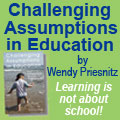 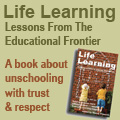 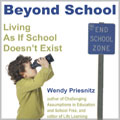
 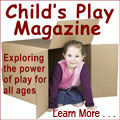 
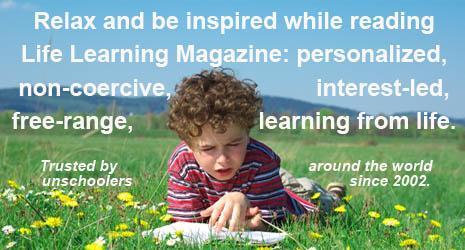
|

